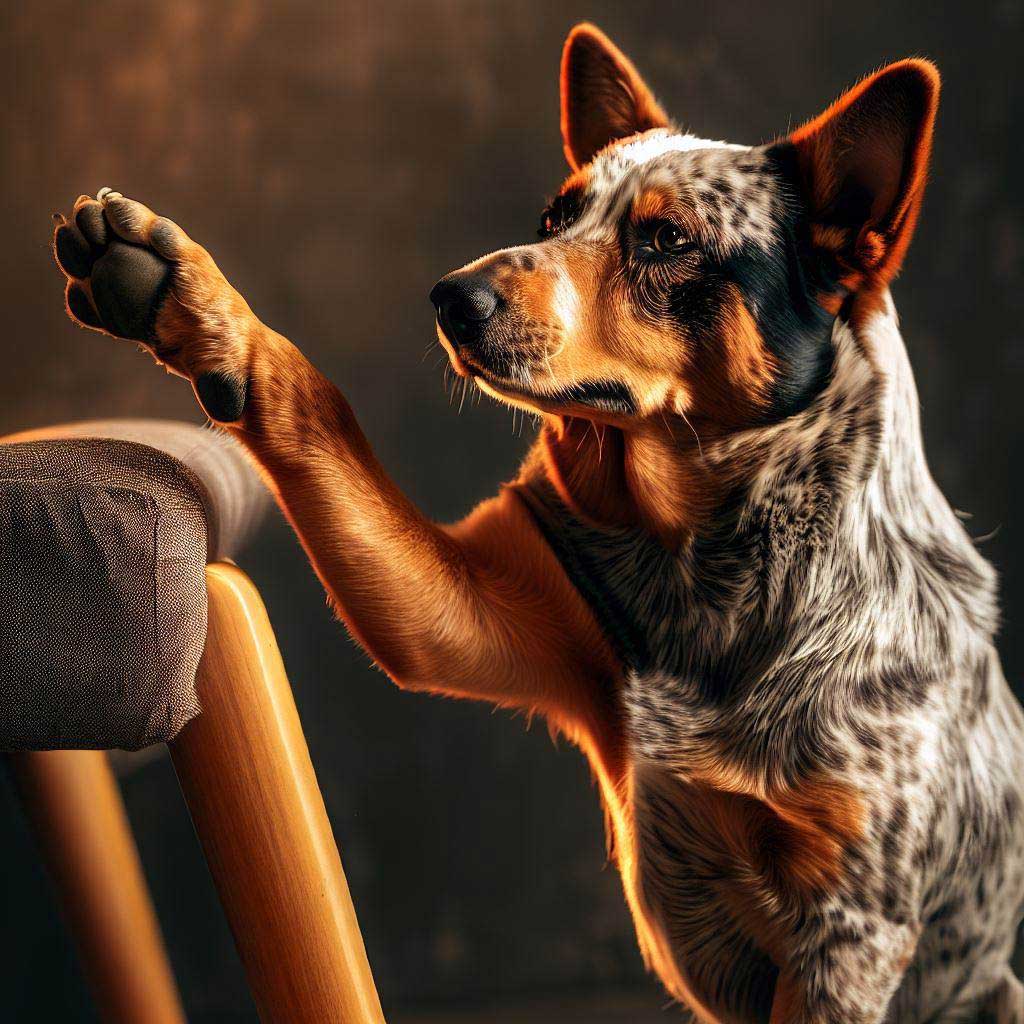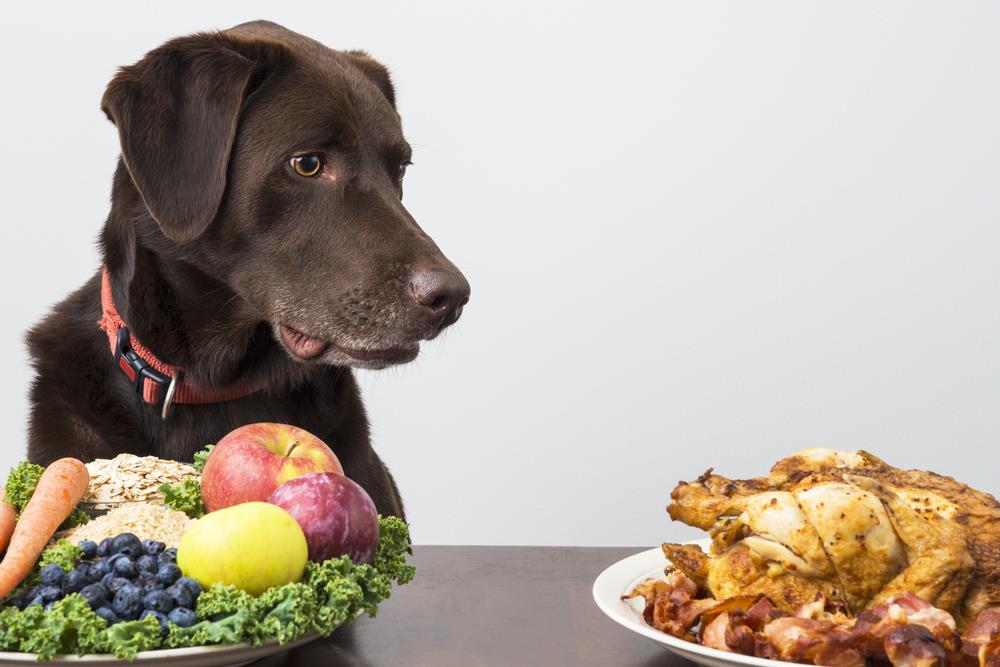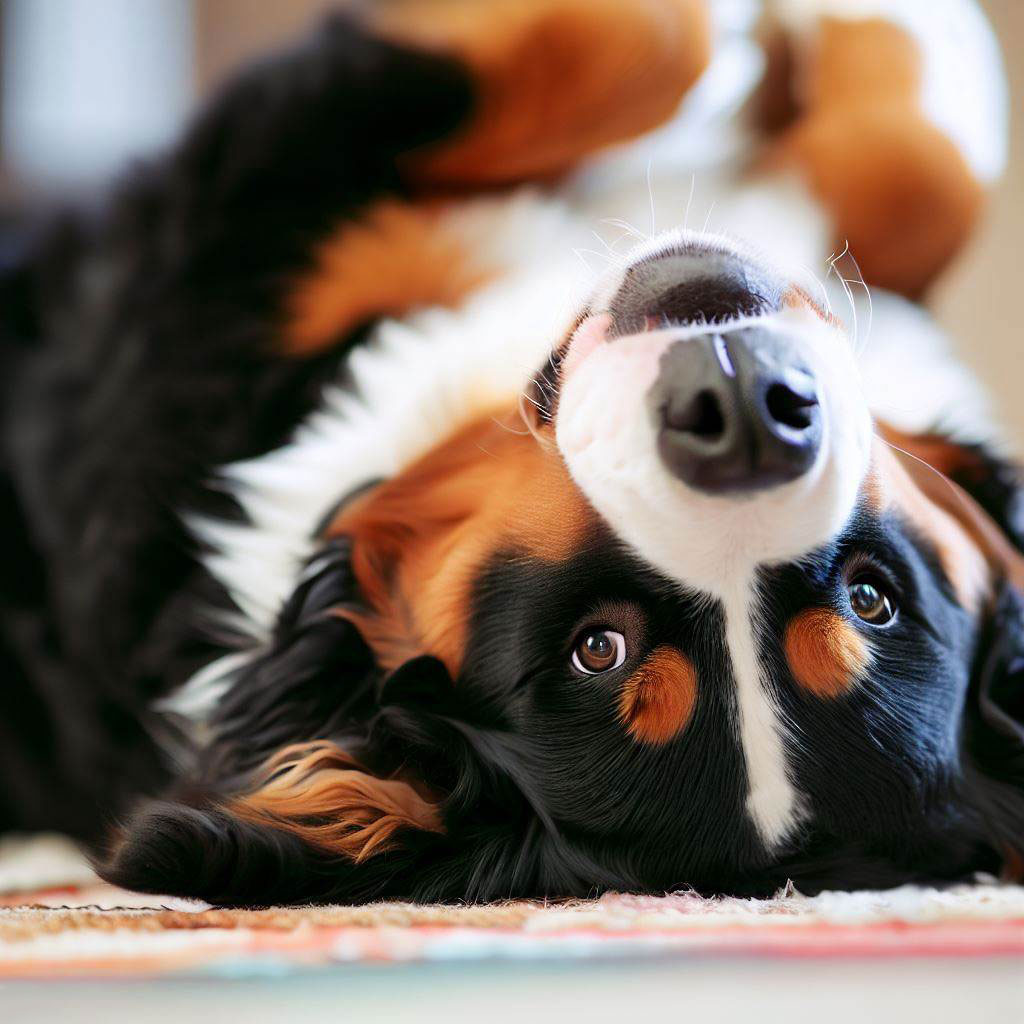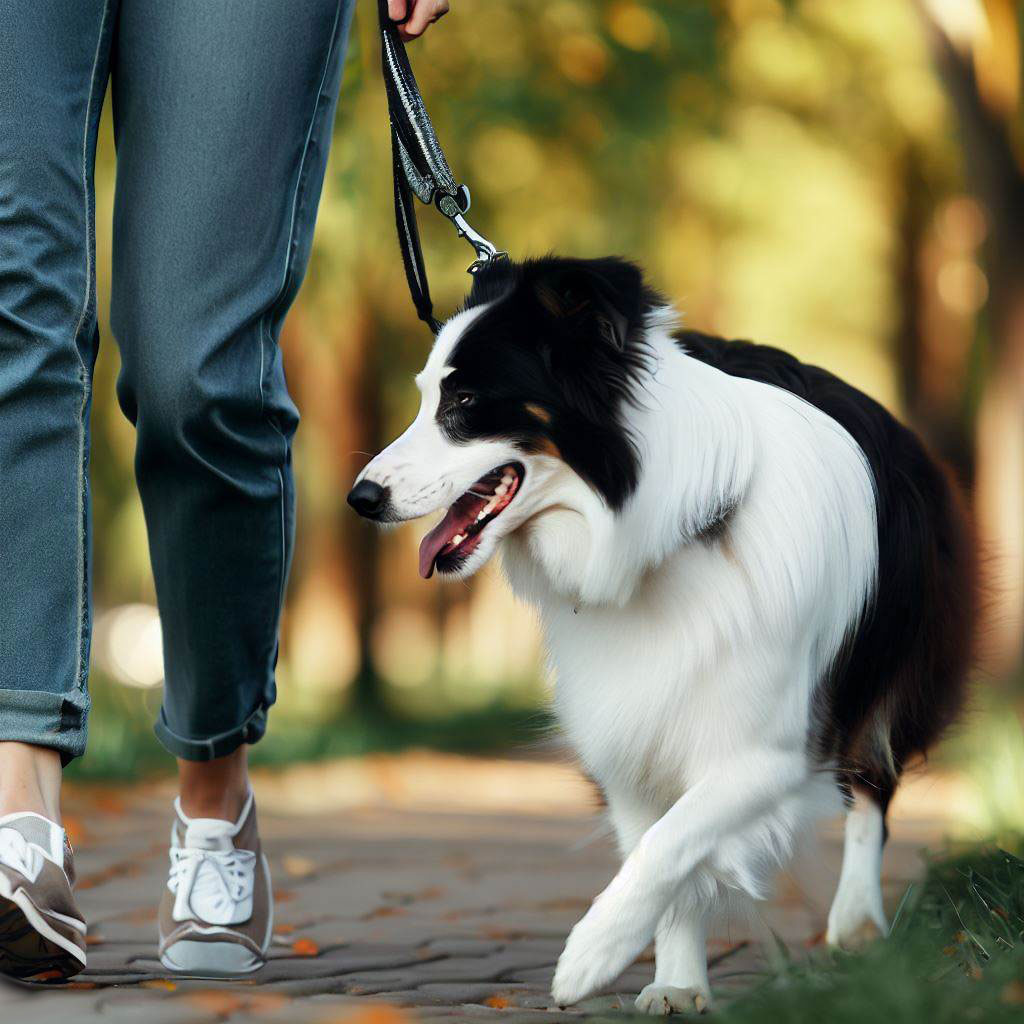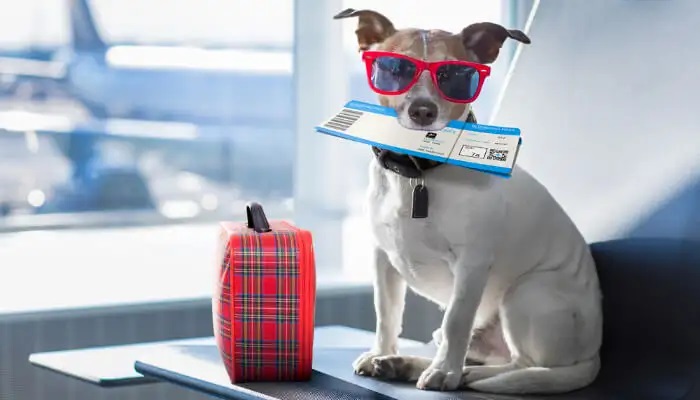How to Teach a Dog Paw: Dog Training Tips made easy. Learn from experts, step by step, and bond with your beloved pooch today!
Table of Contents
Introduction: How to Teach a Dog Paw
The importance of teaching a dog ‘paw’
Teaching a dog ‘paw’ is much more than a delightful party trick. As pet owners, we often overlook the significance of such commands, failing to realize that something as simple as knowing how to teach a dog paw can foster a closer relationship between human and pet. The importance of this interaction extends far beyond the surface.
Firstly, the paw command can be a bonding exercise. Dogs are social animals, and when you engage with them in training, especially in a gentle and rewarding way, it helps build trust and understanding. Thus, teaching your dog to give paw is an opportunity to connect, reinforcing the emotional bond you share.
Secondly, this exercise enhances discipline. Understanding how to teach your beloved pooch to paw means that you must also grasp the principles of positive reinforcement. With patience and consistent training, the paw command encourages obedience in other areas as well, laying the groundwork for further training.
Lastly, it promotes mental stimulation. Dogs need both physical and mental challenges to stay happy and healthy. Training them in commands such as giving paw helps to keep their minds sharp and engaged, warding off boredom that might lead to destructive behavior.
Now, you might wonder why it is so crucial, and how to teach a dog paw effectively. This command has practical applications, too, which leads us to the next section.
The usefulness and benefits of the trick
Not only is teaching your dog to give paw an endearing spectacle, but it also serves functional purposes. Here are some of the additional advantages:
- Health Checks: Once a dog is comfortable with the paw command, it becomes easier for you or a veterinarian to examine the dog’s paw for any signs of injury or infection. Regularly practicing how to teach a dog paw makes the dog more relaxed about having its paws handled.
- Grooming: Trimming a dog’s nails can be challenging. However, if the dog is trained to give paw, it can facilitate grooming by making the animal more cooperative.
- Socialization: Teaching the paw command is an excellent means of socialization. The repetitive and gentle nature of this training helps to desensitize the dog to touch, making it more comfortable around strangers and other animals.
- Control: A well-trained dog is a joy to be around. Knowing how to teach your dog to paw contributes to a broader training routine, increasing your control and the dog’s responsiveness to commands.
In summary, the process of learning how to teach a dog paw is more than a mere spectacle or cute trick. It has real, practical applications, contributing to a more content, obedient, and well-socialized pet. It’s a small step in a long journey, but one that pays dividends in the relationship between you and your furry friend.

Understanding the Paw Command
The psychology behind the paw command
The act of teaching a dog to ‘paw’ is not merely a mechanical process. Understanding the psychology behind the paw command provides you with deeper insight into how to teach your furry friend more effectively.
First, let’s delve into canine psychology. Dogs, by nature, are pack animals, and they seek a leader. When you teach your dog to give paw, you’re taking on that leadership role, guiding your furry friend towards acceptable behavior.
Additionally, the psychology behind the paw command can be linked to a dog’s natural instincts. When wolves and wild dogs want to show submissiveness or appeal for something, they often reach out with their paw. So, by teaching this command, you are connecting with an innate canine language.
This understanding of your dog’s psyche will shape the way you approach the task. As you become familiar with how to teach your pooch to paw, you’ll need to communicate in a way your pet comprehends, using body language and verbal cues that resonate with them.
How dogs perceive this command
When considering how to teach a dog paw, you must understand how dogs perceive this command. Here’s a breakdown of what happens in a dog’s mind:
- Attention and Focus: Your dog notices you’re engaging with them. They see your hand or the treat and focus on the object or gesture.
- Processing: As you repeat the command, they begin to associate the word “paw” or your chosen cue with the act of lifting their paw. They recognize that this specific action will lead to a reward.
- Response: Eventually, the dog responds to the cue alone without needing to see a treat or special hand signal. They understand that giving paw equals praise and reward.
Understanding how dogs perceive the paw command and process it is essential. It helps you recognize that teaching this trick is not an overnight feat. Patience, repetition, and persistence are required as you learn how to teach a dog paw, as they begin to connect the dots between the cue and the desired response.
Importance of positive reinforcement
Positive reinforcement is the cornerstone of how to teach a dog paw or any other command. But what is it, and why is it so vital?
- What It Is: Positive reinforcement involves rewarding your dog when they perform the desired action. Whether through praise, treats, or play, it communicates to the dog that they’ve done something right.
- Why It Works: Dogs respond well to positive reinforcement because it fosters a positive association with the desired behavior. By rewarding your dog when they give paw, you’re reinforcing that specific behavior, making it more likely to be repeated.
- Building Trust: Positive reinforcement builds trust between you and your pet. When they understand that obeying commands leads to pleasant experiences, they become more willing to cooperate and learn.
- Avoiding Negative Behavior: Unlike punishment-based training, positive reinforcement doesn’t cause fear or confusion. It’s a clear and effective way of guiding your dog towards the desired action without negative side effects.
- Tailoring the Approach: Understanding your dog’s favorite rewards and what motivates them is essential. Some dogs may prefer treats, while others might value play or affection more. Customizing your approach is part of understanding how to teach a dog paw successfully.
The use of positive reinforcement is not just about training; it’s about building a relationship with your dog. It’s a communication tool that respects and leverages the dog’s natural inclinations, facilitating a joyful learning experience.
Understanding the psychology of the paw command, how dogs perceive this command, and the essential role of positive reinforcement gives you a robust foundation for training. This insight can transform how you approach the task of teaching your dog to paw, making the process more effective, enjoyable, and nurturing the bond between you and your pet.
Preparing to Teach a Dog Paw
The right age and temperament for teaching this command
When it comes to understanding how to teach a dog paw, knowing the right age and temperament for this task is vital. Here’s what you need to consider:
- Age Consideration: Puppies as young as eight weeks can begin to learn basic commands. However, the paw command might be more appropriate to introduce around four to six months when they have better control over their limbs. Older dogs can learn this trick as well, so it’s never too late to start.
- Temperament Evaluation: Not all dogs will respond the same way. Assessing your dog’s personality helps you approach training in a way that suits them. Does your dog enjoy physical touch and interaction? Are they shy or nervous? Understanding their temperament allows you to tailor how to teach a dog paw, making the process enjoyable for both of you.
- Patience and Understanding: Every dog learns at a different pace. Some might grasp how to give paw quickly, while others need more time. It’s vital to recognize their unique pace and provide consistent, patient guidance.
Necessary tools and treats
Before you dive into the training itself, you’ll need to gather the proper tools and treats. Here’s what will help you succeed in teaching your dog to paw:
- Training Treats: High-value treats can be a great motivator. These should be small, easily digestible, and something your dog loves. They’ll be the reward for each successful paw, reinforcing the behavior.
- Clicker (Optional): If you’re using clicker training, having a clicker on hand can help mark the exact moment your dog performs the desired action.
- A Comfortable Leash and Collar: If you’re training in an area where distractions might lead your dog astray, a comfortable leash and collar will help keep them focused.
- A Mat or Comfortable Surface: Especially for puppies, a soft surface to stand on can make the training sessions more comfortable.
When preparing to teach a dog paw, these tools and treats aren’t just accessories; they’re essential components that support the training process.
Creating the perfect environment
The environment in which you choose to teach your dog to paw plays a crucial role. Here’s how to create the perfect setting:
- A Quiet Space: Start in a quiet area with minimal distractions. This allows your dog to focus on you and the task at hand.
- Consistent Location: Consistency helps your dog understand that it’s time to work. Whether it’s a specific room or a corner of your yard, using the same space signals to your dog that it’s training time.
- Avoid Overstimulation: Loud noises, other pets, or too many people can overwhelm your dog, making it hard for them to focus on learning how to give paw. Keeping distractions to a minimum aids in effective training.
- Comfort: Ensure the space is safe and comfortable for both you and your dog. The temperature, flooring, and space to move should all be conducive to a positive learning experience.
In preparing to teach a dog paw, the environment is more than just a backdrop; it’s a vital element that can either enhance or hinder the learning process. By carefully considering age and temperament, having the necessary tools and treats on hand, and crafting the ideal environment, you set the stage for successful training, making the path to learning how to teach a dog paw smooth and enjoyable.
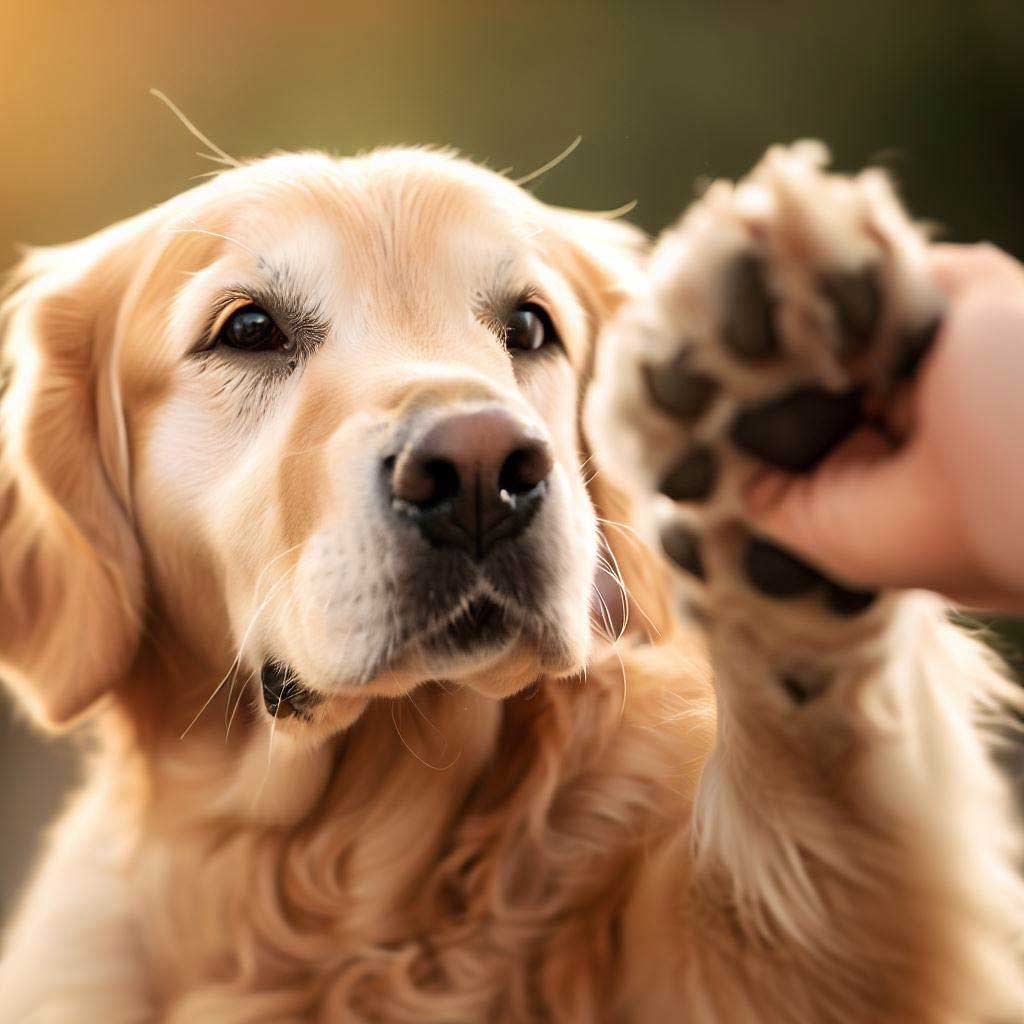
Step-by-Step Guide: How to Teach a Dog Paw
Starting Position
- Proper posture for the dog: Setting the right posture for your dog is the first step in how to teach a dog paw. Ensure that your dog is in a comfortable sitting position with their weight evenly distributed. Their attention should be focused on you, and they should be relaxed yet alert.
- Choosing the correct hand signal and command: Select a clear and specific hand signal and verbal command for this trick. Most trainers prefer using the word “paw” or “shake,” accompanied by an extended hand or a gentle tap on the paw. Consistency in both hand signals and verbal commands will help your dog understand what you expect from them.
The Lure Technique
- Detailed explanation of the process: The lure technique is often used in the beginning stages of teaching this trick. Here’s how to do it:
- Hold a treat in your hand and let your dog sniff it, but don’t let them take it.
- Move the treat from their nose towards their shoulder, causing their head to follow the treat and lift the opposite paw naturally.
- As the paw lifts, use the chosen command, like “paw.”
- Reward them with the treat and praise as soon as the paw lifts.
- Repeat until your dog starts responding to the command without needing the lure.
- How to Teach a Dog Paw with treats: Treats are essential tools in teaching a dog to paw. They serve as both a lure and a reward. High-quality, small-sized treats that your dog loves will make the process more engaging and enjoyable for your pet. How to teach a dog paw with treats is about using this motivator wisely, never overfeeding, and gradually reducing the treats as your dog masters the command.
Positive Reinforcement
- Rewarding good behavior: When learning how to teach a dog paw, remember that rewarding good behavior goes beyond treats. Verbal praise, affection, and play can also be powerful motivators. Acknowledge every correct response, even if it’s not perfect at first, to encourage progress.
- Timing of treats and praise: The timing of treats and praise is crucial. Reward your dog the instant they perform the desired action. This immediate reinforcement helps them associate the behavior with the reward, reinforcing the learning.
Practice and Consistency
- Setting a regular schedule: Like any other training, teaching a dog paw requires a regular schedule. Short, consistent practice sessions, such as 5-10 minutes daily, can be more effective than longer, sporadic training.
- How long it usually takes to teach this trick: The time it takes to teach a dog to paw varies widely depending on the individual dog, their age, and prior training experience. Some might learn in a single session, while others might take a few weeks. Patience and persistence are key in how to teach a dog paw.
Troubleshooting Common Issues
- Addressing refusal or confusion: If your dog is refusing or seems confused, take a step back and evaluate your approach. Are you being clear and consistent with your commands and signals? Is the environment too distracting? Reassess and make necessary adjustments. Sometimes, breaking down the process into smaller steps can alleviate confusion.
- Handling misbehavior: Misbehavior, such as jumping or using the wrong paw, should be handled calmly. Ignore the incorrect response and do not reward it. Instead, patiently repeat the command and guide your dog towards the correct action. Remember, knowing how to teach a dog paw involves recognizing that mistakes are a natural part of learning.
Teaching your dog to paw is a rewarding experience that enhances communication and builds trust. This step-by-step guide breaks down how to teach a dog paw into manageable stages, offering insights and strategies to make the process effective and enjoyable.
From setting the right starting position to using lure techniques, positive reinforcement, consistent practice, and troubleshooting common issues, these instructions provide a comprehensive approach to teaching this endearing trick.
Advanced Tips and Tricks
Teaching variations such as “high five”
Once your dog has mastered the basic paw command, you can build on that foundation to teach more advanced variations, like the “high five.” Here’s a step-by-step guide on how to teach this exciting variation:
- Start with the Basic Paw Command: Ensure that your dog is confident with giving their paw. This will make the transition to the “high five” smoother.
- Introduce a New Command and Gesture: Choose a new command such as “high five” and accompany it with a raised hand, palm facing your dog. Make the distinction clear so your dog understands that this is a different request.
- Use Positive Reinforcement: As you guide your dog’s paw to meet your raised hand, reinforce with treats and praise. Consistency and patience are key here.
- Gradually Increase the Challenge: Start by asking for a “high five” from the sitting position. Once mastered, you can ask for it while your dog is standing or even jumping.
- Practice and Refinement: Like the process of learning how to teach a dog paw, practice and refinement are essential to perfecting the “high five.”
Teaching variations like the “high five” is a fun way to challenge your dog and keep them engaged. It builds on the foundational skills developed when learning how to teach a dog paw, allowing you and your dog to enjoy an even richer training experience.
Integrating the paw command into other training routines
Integrating the paw command into other training routines is a strategic way to reinforce this skill and create a more comprehensive training program. Here’s how to do it:
- Combine with Other Commands: You can sequence the paw command with others, such as “sit” or “stay.” This teaches your dog to respond to multiple commands in succession.
- Create Fun Games: Games like “patty-cake” can include the paw command and turn training into playtime.
- Use in Behavioral Training: If your dog tends to jump on guests, you can redirect this energy by asking for a paw instead. It’s a positive way to channel their excitement.
- Include in Agility Training: Teaching a dog paw can be the stepping stone to more advanced agility training, where precise paw placement is crucial.
- Reinforce During Everyday Interactions: Casual reinforcement during daily activities reminds your dog that commands apply in various contexts, not just formal training sessions.
Integrating the paw command into other routines makes training more dynamic and can enhance overall obedience and responsiveness. It reflects a holistic approach to how to teach a dog paw, where the skill becomes part of a broader, well-rounded training program.
Conclusion: How to Teach a Dog Paw
The journey of how to teach a dog paw encompasses understanding your dog’s psychology, preparing properly, following a step-by-step guide, employing advanced techniques, and integrating the command into other routines. It’s a multifaceted process that goes beyond merely teaching a trick. It’s about communication, bonding, and developing a set of skills that benefit both you and your dog.
Encouragement and final tips for success
As you embark or continue on this rewarding journey, remember that patience, consistency, positive reinforcement, and an understanding of your dog’s unique needs and temperament are your best allies. Learning how to teach a dog paw is not just about the final result; it’s about the enriching experience and the strengthened bond between you and your furry friend.
Don’t hesitate to explore variations and creatively integrate the paw command into your regular training routine. Keep sessions enjoyable, positive, and engaging, and you’ll find that teaching your dog to paw can be an enjoyable and satisfying experience.
In conclusion, the process of how to teach a dog paw offers endless opportunities for fun, growth, and connection. Whether you’re teaching the basic paw command, advanced variations like “high five,” or integrating it into other training routines, you’re opening doors to a deeper understanding and relationship with your beloved pet.
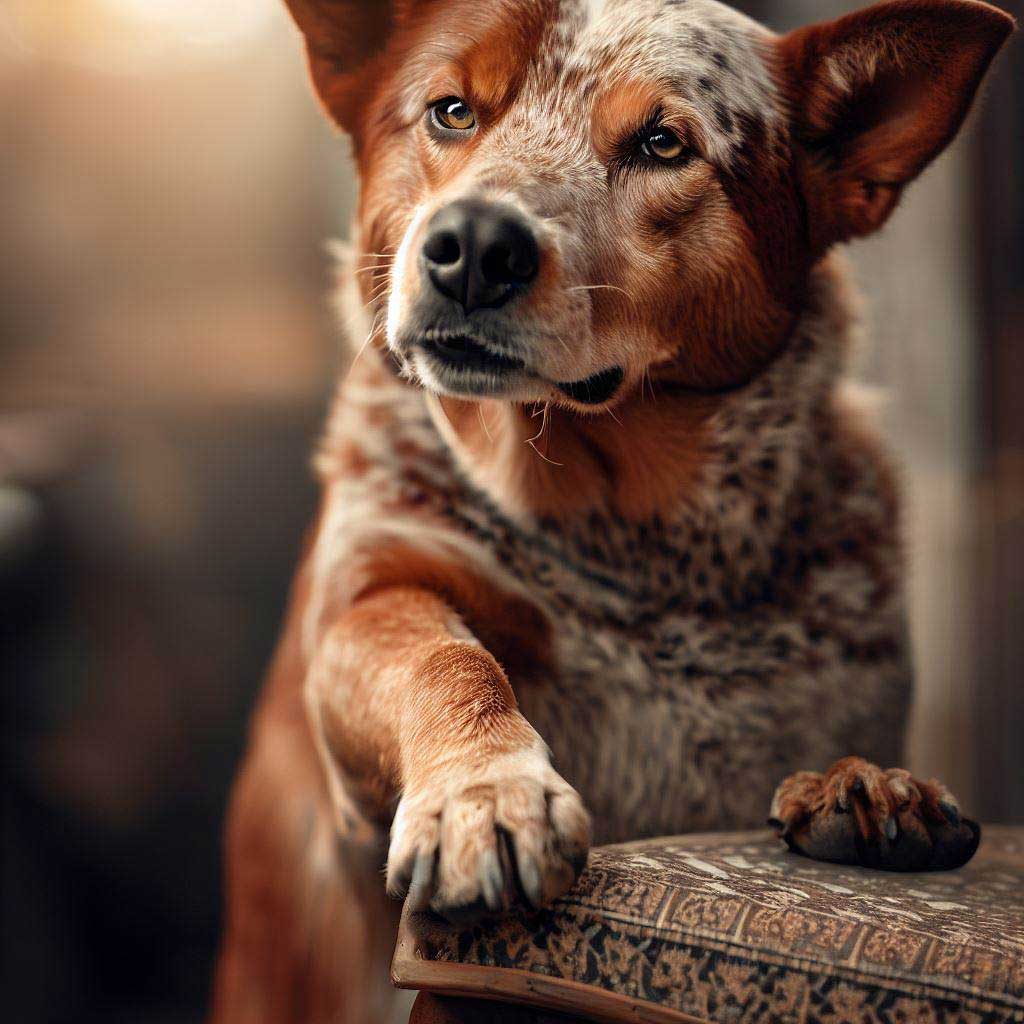
FAQs: How to Teach a Dog Paw
Should I teach my dog paw?
Absolutely! Teaching a dog paw is more than just a fun trick. It enhances communication, helps with grooming, and can be a part of behavioral training. Furthermore, learning how to teach a dog paw can foster bonding and build trust between you and your canine companion.
What age can I start teaching my dog the paw command?
Generally, you can start teaching the paw command when a puppy is around 3 to 4 months old. At this age, they typically begin to grasp basic commands, and learning how to teach a dog paw becomes an achievable task. However, even an older dog can learn this command, so it’s never too late to start.
Can all dog breeds learn how to give paw?
Yes, nearly all dog breeds can learn how to give paw. The approach might vary slightly based on the breed’s size, temperament, and physical abilities, but the core principles of how to teach a dog paw remain the same across different breeds.
How long does it take for a dog to learn paw?
On average, a dog might take a week or two to learn the paw command, practicing a few minutes every day. However, this can vary significantly depending on the individual dog’s learning pace, your consistency, and how you approach teaching the paw command.
Can you teach a dog left and right paw?
Indeed, teaching a dog left and right paw is possible and can be a fun extension of the basic paw command. It adds an extra challenge and engages the dog’s cognitive skills. The differentiation between left and right builds on the principles of how to teach a dog paw, using distinct cues and consistent reinforcement for each side.
What if my dog refuses to learn the paw?
Give it time, if your dog seems to refuse learning the paw command, don’t worry. This might be a sign of confusion or discomfort. Reevaluate your approach, ensure you give lots of positive reinforcement, and break down the learning process into smaller, manageable steps. Understanding how to teach a dog paw requires patience and adaptability.
Are there any specific tools required to teach a dog paw?
No specific tools are required for teaching a dog paw, although having treats or a clicker can be helpful for positive reinforcement. The main focus should be on your approach, understanding, and connection with your dog.
Can I teach my dog both “paw” and “high five”?
Yes, teaching your dog both “paw” and “high five” is an excellent way to expand their repertoire and keep training engaging. It reflects a deeper understanding of how to teach a dog paw and can lead to even more creative variations.
What type of treats are best for training a dog to paw?
The best treats for training a dog is soft, bite-sized treats that your dog loves and are typically the best choice. Make sure they’re nutritious and suitable for your dog’s diet.
How can I ensure that my dog only gives paw on command?
Consistency with any dog is key. Reward the behavior only when it’s performed on command, and use a clear and distinct cue. This understanding of when and how to reinforce the behavior is integral to learning how to teach a dog paw effectively. It won’t happen overnight, so give it time and lots of persistence.
Should you teach a puppy paw?
Yes, teaching a puppy paw is a gentle and fun introduction to training. It’s an excellent way to initiate a puppy into basic obedience and engage their curiosity.
Should I teach my dog shake hand or paw?
Whether you use “shake” hand or “paw” is a matter of preference. The key is consistency in whatever command you choose.
How do you teach a paw a target?
Teaching a paw target involves guiding your dog’s paw to a specific object or location using a command, hand signal, and positive reinforcement. This is very acheiveable but like anything, takes lots of consistency and patience.
Is it normal for a dog to favor one paw over the other?
Yes, it’s common for dogs to have a preference for one paw, because much like humans they may be right or left-handed.
Can I teach a dog paw even if I am not a professional trainer?
Certainly! With patience, understanding, and following proper guidelines on how to teach a dog paw, you can successfully train your dog even without professional experience.
What are easy tricks to teach your dog?
Sit, shake, lie down, and roll over are some of the easiest tricks to teach a dog, requiring patience and consistent positive reinforcement. Remember, a tasty treat is required for most training to make the process a lot easier.
My dog won’t give paw
This may be due to confusion or discomfort; ensure clear communication, break down the steps, and use positive reinforcement to encourage progress. Give it time and lots of patience, and you’ll succeed. And don’t forget a treat or two during the process.
How to train a puppy to sit and shake
How to train amy puppy to sit and shake is by using treats, verbal cues, hand signals, and rewarding good behavior consistently.
Is paw dog training useful in dog sports?
Yes, paw dog training can be useful in dog sports, enhancing coordination, obedience, and helping to form a stronger handler-dog bond.
How to teach a dog to roll over
Use treats to lure your pet dog into a lying position, then guide them to roll over, rewarding and praising them as they complete the action. For good advice and some top tips read our artcicle on How to Teach a Dog to Roll Over.
How to teach a dog to sit
Use a treat above your dog’s head to guide them into a sitting position, then reward and praise them for following the command. A treat they like helps wonders with the process.
How to teach a dog to lay down
Lure the dog into a lying position with a treat or hand signal, then reward and praise them once they obey the command. A treat they like helps wonders with the process.
How to teach a dog to shake hands quickly
Guide the paw with a treat or touch, say the command, and provide immediate praise and reward for the correct behavior. The reward initially will be a treat but then reaplce the treat and give your dog lots of praise.
Can you use a treat to teach a dog to shake?
Yes, treats can be highly effective for teaching a dog to shake, providing a motivational incentive for them to learn.
Best way to research for training dogs to shake hands
Research online resources, books, or consult with professional trainers for diverse methods and personalized advice on training dogs to shake hands.
Where to get good advice for better paw performance?
Consult a professional dog trainer, attend local training classes, or explore reputable online forums and videos for expert advice on paw performance.
How do you teach a dog heel command?
Teach the heel command through consistent verbal cues, hand signals, guiding the dog by your side, and rewarding good behavior. For some great tips and tricks read our post on How to Teach a Dog to Heel.
Do you get better paw performance using a dog trainer?
Professional dog trainers often have experience and techniques that can improve paw performance, but success also depends on the handler’s commitment and the dog’s temperament.
Can a dog use both paws to shake?
Yes, with proper training and consistent cues for each paw, a dog can be taught to shake with both paws.
Does using both paws hurt a dog?
No, using both paws does not hurt your pet dog, provided that the training is conducted gently and positively. Dogs naturally use both paws for various tasks, and teaching them to shake with either paw should not cause any discomfort. However, it is essential to observe the dog’s body language and responsiveness to ensure that the training process is enjoyable and free from stress.
Can dry food be used as a treat for my dog to shake?
Yes, dry food can be used as a treat to encourage your dog to shake. Many dogs will respond positively to their regular dog food or kibble as a reward, especially if they find it tasty. Give then what they’re used to and it’ll make the process a lot easier.
